2016-2018 Highlights
2018
Postdoctoral Associate Position at CSU Fullerton, Application Review to Begin 10/31/18
The Gravitational-Wave Physics and Astronomy Center (GWPAC) at California State University Fullerton welcomes applications for a Postdoctoral Associate in Gravitational-Wave Physics. GWPAC faculty members include Al Agnew, Geoffrey Lovelace, Jocelyn Read, and Director Joshua Smith. Its research projects include searches for binary systems with black holes and neutron stars with the Laser Interferometer Gravitational-wave Observatory (LIGO), characterization of the LIGO detectors, waveform modeling including analytical solutions for neutron stars with realistic equations of state, modes and tides, numerical relativity simulations of binary black hole and black hole neutron star systems as part of the Simulating eXtreme Spacetimes (SXS) Collaboration, optical characterization of LIGO optics, theoretical calculations of thermal noise and mathematical relativity.
The successful applicant will establish and carry out a research program in gravitational-wave physics that complements the existing strengths in GWPAC and involves undergraduate and master's students. Contributions to the study of third-generation gravitational-wave science and/or detector development are expected as part of their research activities.
Women and members of groups traditionally underrepresented in physics and astronomy are especially encouraged to apply.
The application deadline is October 31,
2018
or until filled. To be considered for this position, please submit an application![]() .
.
On the application website, please submit the names and contact information of three references. We also ask that you attach a cover letter, a short statement of research interests, and a curriculum vitae. If you have any questions, please email Jocelyn Read at jread@fullerton.edu![]()
Scientific American and World Science Festival: Jocelyn Read Talks Extreme Neutron Star Matter
Jocelyn Read leads LIGO's Extreme Matter group and has been central in the gravitational-wave community's exploration of the matter involved in the neutron-star merger known as GW170817, measured by LIGO and Virgo in 2017. The team's research was described today, including a quote from Jocelyn, in the Scientific American article "Gravitational Waves Reveal the Heart of Neutron Stars."
This article arrives on the heels of Jocelyn visiting New York City and Palm Springs to discuss the results at three venues.
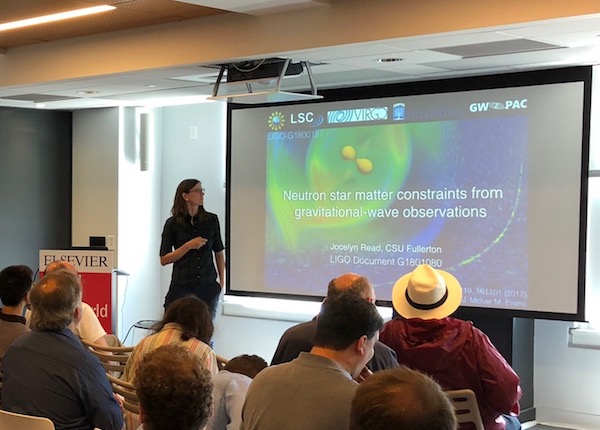
Jocelyn Read speaks at Columbia University’s Center for Theoretical Physics.
She was part of a four-person panel, each among the foremost experts in gravitational-wave astrophysics, discussing "A Merger in Space: Black Holes And Neutron Stars" at the NYU Grand Hall, as part of the Big Ideas Series (supported in part by the John Templeton Foundation) and the World Science Festival.
She also spoke at the workshop "Nuclear astrophysics in the new era of multi-messenger astronomy," which was organized by Annals of Physicsand took place at Columbia University’s Center for Theoretical Physics on 30 and 31 May, also in collaboration with the World Science Festival.
And over the weekend, she gave a plenary presentation at the Thirteenth Conference on the Intersections of Particle and Nuclear Physicsin Palm Springs, CA.
Great work on understanding neutron star matter by Jocelyn and the LIGO Scientific Collaboration and Virgo!
2017
GWPAC Graduates 2017
This Sunday, May 21, five students from Cal State Fullerton's Gravitational-Wave Physics and Astronomy Center (GWPAC) will graduate and enter graduate schools and industry. Additionally, two of our 2016 graduates will enter graduate school programs.
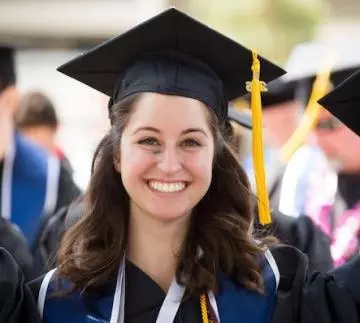
Nousha Afshari, who delivered one of the twostudent speechesat the 2016 College of Natural Sciences and Mathematics Commencement alsoworked at Johnson and Johnson; shewill pursue a PhD. While in GWPAC Nousha was the undergraduate system administator for the ORCA computing cluster and performed numerical simulations of merging black holes.
Nick Demos, mentored by Dr. Geoffrey Lovelace, co-authored a paper on merging black holes published in the journal Classical and Quantum Gravity and helped develop code to simulate thermal noise in gravitational-wave detector optics. Nick will graduate with a BSc this Sunday and begin Ph.D. studies in physics at MIT this fall.
Alyssa Garciawill graduate on Sunday with a BSc in physics. Alyssa’s research focuses on analyzing and comparing model gravitational waveforms for colliding black holes, she has presented her work at regional, national, and international conferences, and she is a co-author on a paper published in Classical and Quantum Gravity in which she presents her results comparing different computational models of the first gravitational waves that LIGO measured. She will begin PhD studies in physics at Brandeis University this fall.
John Derbywill graduate on Sunday with a master's degree in physics.He used supercomputer simulations of merging black holes to test whether they obey the “spin limit” that has been proven to hold for single black holes. We don’t know for sure whether that limit can be violated when two black holes merge, but John found that it held in a simulation of merging black holes with the highest initial black-hole spins to date. John also used simulations to explore how black holes tear apart neutron stars when the black hole is rapidly spinning.
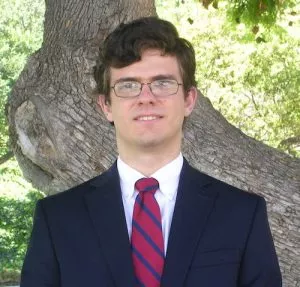
Ha roon Khanis graduating in May 2017 with a major in electrical engineering and a minor in physics. Haroon transferred to Cal State Fullerton, motivated by his participation in the STEM^2 Summer Research Experience, in 2014. His research continues his STEM^2 work in the department of physics, where has focused on visualizing merging black holes and their spacetime curvature. Haroon has helped to make images and movies of merging black holes that have appeared in the national and international media. Haroon looks forward to a career in engineering, and hopes one day to work as an aerospace engineer at NASA.
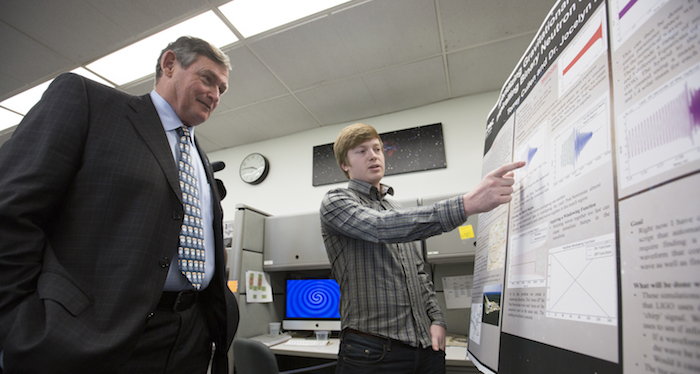
Torrey Cullen, a 2016 BSc graduate in physics, and a current research associate in GWPAC with Dr. Jocelyn Read, will be entering a PhD program in gravitational physics and optics at Lousiana State University. Currently Torrey and Dr. Read are writing a paper on the detectability of astrophysical effects from neutron star matter in gravitational-wave signals.
Three of these GWPAC graduates: Alyssa Garcia, Nick Demos, and Haroon Khan (all three supervised by Dr. Lovelace) won this year's Outstanding Student Scholarly Awards in the College of Natural Sciences and Mathematics and the College of Engineering.
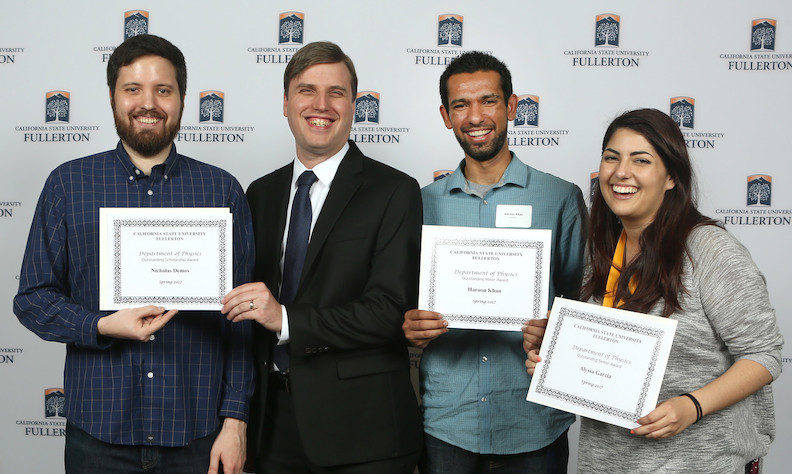
GWPAC is extremely proud of all of your accomplishments and we are excited to see what the future holds for you!
GWPAC Scholars Sweep Student Scholarly and Creative Activities Awards
Three GWPAC undergraduate student researchers, Nick Demos and Alyssa Garcia (College of Natural Sciences and Mathematics) and Haroon Khan (College of Engineering), all supervised by Professor Geoffrey Lovelace, will receive the California State University Fullerton’s 2017 Outstanding Student Scholarly and Creative Activities Award.
On April 3, 2017, CSU Fullerton’s Associate Vice President for Research and Sponsored Projects, Dr. Chris Liu, announced the recipients to the campus community, saying,
“The award recognizes excellence in student participation in research or creative activities, and is presented to one undergraduate and one graduate student per college working collaboratively with a faculty member or independently on a research project or creative activity.”
The recipients will be honored at Student Creative Activities and Research Day on Wednesday, April 12th from 1:00-1:30 P.M. in the TSU Pavilion A.
This is the first time that a GWPAC student has won this award, and we are extremely proud that GWPAC student researchers swept the undergraduate awards for both the College of Natural Sciences and Mathematics and the College of Engineering. All three students will graduate in May 2017 and we are excited about what the future holds for them.
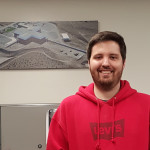
Nick Demos has been admitted to several major Ph.D. physics programs, including at Caltech and MIT, and he is looking forward to pursuing graduate study in physics this fall. Nick’s research focuses on using supercomputers to model gravitational waves from merging black holes and thermal noise in LIGO mirrors. He has presented his work at regional and national meetings, he has helped to create visualizations of merging black holes that have appeared in the national and international media, and he is a co-author on a paper published in Classical and Quantum Gravity, in which he presents some of his results.
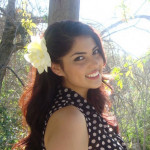
Alyssa Garcia has also been admitted to several major physics Ph.D. programs, including Brandeis University, Syracuse University, and Penn State. Alyssa’s research focuses on analyzing and comparing model gravitational waveforms for colliding black holes. She has presented her work at regional, national, and international conferences, and she is a co-author on a paper published in Classical and Quantum Gravity in which she presents her results comparing different computational models of the first gravitational waves that LIGO measured.
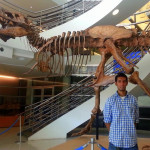
Haroon Khan will graduate in May with a major in electrical engineering and a minor in physics. Haroon transferred to Cal State Fullerton, motivated by his participation in the STEM^2 Summer Research Experience, in 2014. His research continues his STEM^2 work in the department of physics, where has focused on visualizing merging black holes and their spacetime curvature. Haroon has helped to make images and movies of merging black holes that have appeared in the national and international media. Haroon looks forward to a career in engineering, and hopes one day to work as an aerospace engineer at NASA.
Congratulations to all three award winners!
Jocelyn Read Honored by Senator Josh Newman
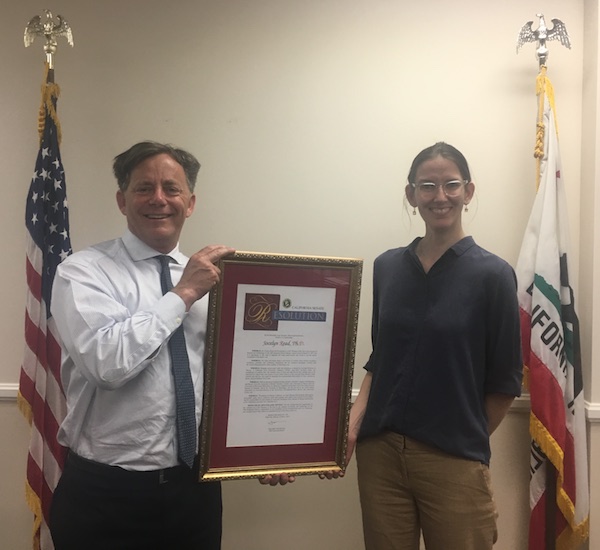
Jocelyn Read has been named Woman of the Year in Science and Technology in 2017 for California's 29th Senate District by California State Senator Josh Newman (See the fullpress releaseinVoice of OC).
Senator Newman welcomed Jocelyn at his Brea offices on Friday, April 21st, presenting her with a California Senate Resolution and speaking with her about her role in the gravitational-wave discovery. CSU Fullerton Master's student Torrey Cullen (who is currently writing a reserach article together with Jocelyn), as well as professors Josh Smith and Geoffrey Lovelace accompanied Jocelyn (as her cheering section). During the visit, the CSUF contingent also had the opportunity to talk about black holes with District RepresentativeKaterina Ioannides.
Jocelyn, an Assistant Professor in California State University Fullerton's Department of Physics, is an astrophysicist and a world's expert on extreme stellar objects called neutron starsand the gravitational-wave signatures they produce. She leads a team of student researchers in CSUF's Gravitational-Wave Physics and Astronomy Center (GWPAC) and in 2016 she contributed to the first direct detection of gravitational waves, a phenomenon predicted by Albert Einstein 100 years earlier (read more). She is also the Principal Investigator of the $1M NSF Partnerships In Astronomy and Astrophysics Researchawardthat is helping to train the next generation of gravitational-wave scientists.
Jocelyn, you are an outstanding teacher, mentor, and researcher. Congratulations on this award from the other members of GWPAC!
Jocelyn Read speaks as Peter Sim Lecturer to the Royal Astronomical Society of Canada - Calgary Centre
On March 29, 2017, Jocelyn Read gave the annual Peter Sim Memorial Lecture for the Calgary chapter of the Royal Astronomical Society of Canada. Her public talk on gravitational waves, black holes, and neutron stars commemoratedPeter Sim, an outstanding public education volunteer.
This capped off an outstanding month for Jocelyn, in which she was named the 2017 Science and Technology Woman of the Year in California's 29th Senate District and served as the Lead Editor forLIGO Magazine, a twice-yearly publication by the LIGO Scientific Collaboration on the latest research, news, and personalities across the collaboration (her message from the editor is onpage 4![]() ).
).
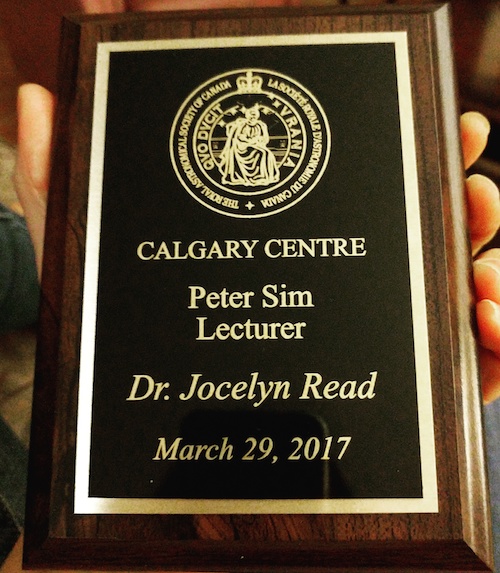
2016
GWPAC 2016 Year in Review
2016 was an extraordinary year for the Gravitational-Wave Physics and Astronomy Center (GWPAC) and the field of gravitational-wave physics in general. This report looks back at some of the center's highlights.
The Discovery of Gravitational Waves from a Binary Black Hole Merger - On September 14, 2015 the Laser Interferometer Gravitational-wave Observatory (LIGO) detectors recorded gravitational waves for the first time. This confirmed Einstein’s prediction from 100 years earlier that changes in gravity create waves of space and time.The source of the waves was also a completely new discovery: two black holes, more than 1 billion light years away from Earth, each around 35 times as massive as the sun, orbiting around each other at a quarter the speed of light. These black holes crashed into each other, forming a new black hole with 67 times the mass of the sun and releasing 3 times the mass of the sun as gravitational-wave energy, according to Einstein’s famous equation E=mc2.
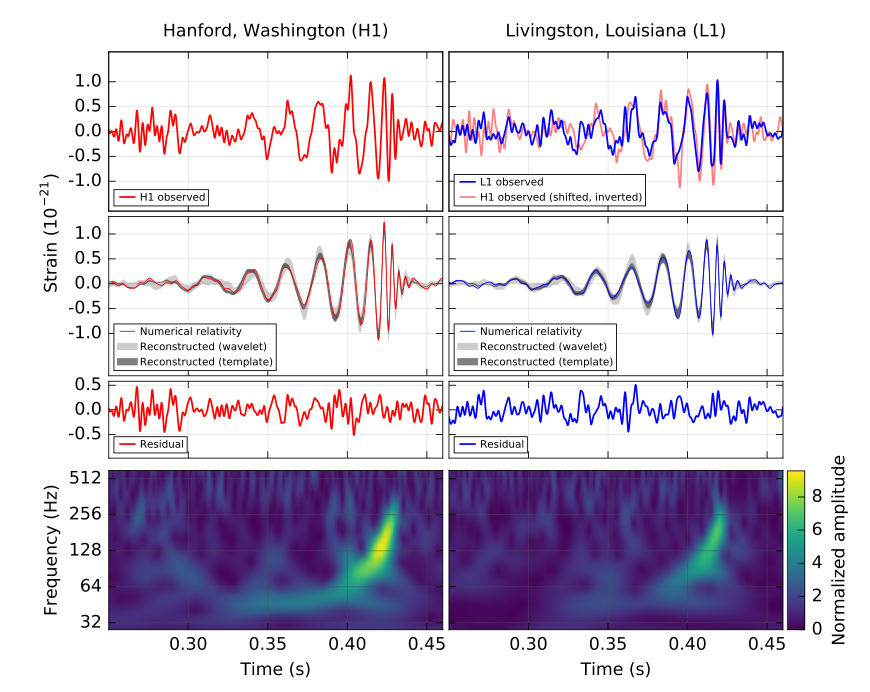
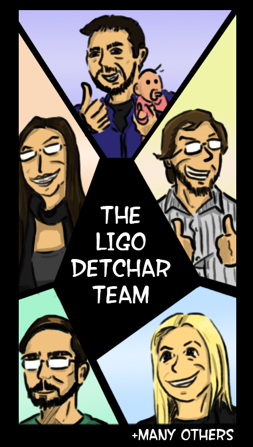
GWPAC played an important role in this discovery. Ten Center members were among the 1000 authors on the landmark paper that announced these results. Josh Smith had the honor of serving as one of the six primary editors![]() for the paper and leading the efforts (the so-called detection checklist) to verify that this was a true gravitational wave and not a terrestrial disturbance. Geoffrey Lovelace performed computer simulations of the binary black hole system that were shown in the paper and also led the production of the famous figures 1 and 2 in the paper. Jocelyn Read helped configure the gravitational-wave searches that found the event, was the editor of the science summary of the paper, and communicated the discovery to the world through LIGO’s Twitter and Facebook outreach campaign.
for the paper and leading the efforts (the so-called detection checklist) to verify that this was a true gravitational wave and not a terrestrial disturbance. Geoffrey Lovelace performed computer simulations of the binary black hole system that were shown in the paper and also led the production of the famous figures 1 and 2 in the paper. Jocelyn Read helped configure the gravitational-wave searches that found the event, was the editor of the science summary of the paper, and communicated the discovery to the world through LIGO’s Twitter and Facebook outreach campaign.
This discovery was announced on February 11, 2016 at the National Press Club in Washington, DC. Smith attended that event. Read, Lovelace and students held a press conference at Cal State Fullerton. The first detection of gravitational waves was the culmination of decades of research. Cal State Fullerton and GWPAC have, for the past six years, made key contributions to gravitational-wave physics as members of the LIGO Scientific Collaboration and Simulating eXtreme Spacetimes collaboration. In particular, GWPAC members contributed to understanding the behavior of the detectors, improving the quality of LIGO optics, modeling gravitational waveforms for binary systems of neutron stars and black holes, and improving LIGO’s gravitational-wave searches. All of this work has paid off in a major way.
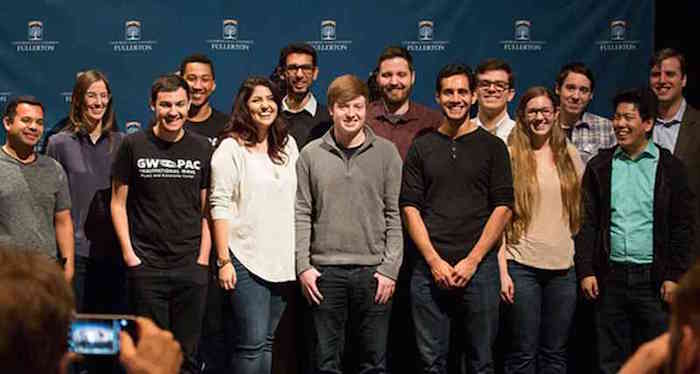
Following the discovery, GWPAC was honored to host CSU Chancellor Tim White, Vice Chancellor Loren Blanchard, and CSUF President Mildred García to discuss the new field of gravitational-wave astronomy and the operations of the Center. Later, together with the College of Natural Sciences and Mathematics, GWPAC hosted the "Gravitational Waves: Examining the Universe in a Whole New Way" event at the Center Club in Costa Mesa. This was attended by friends, faculty, administrators, students, and other supporters. Most notably, this event announced Dan Black and family’s establishment of and major support for the Dan Black Director of Gravitational Wave Physics and Astronomy, inaugurally held by Josh Smith.
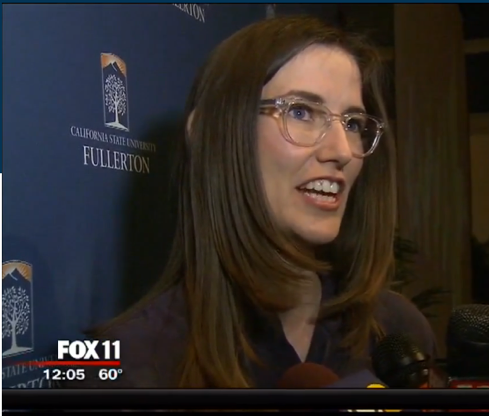
Following the announcement, many GWPAC members were covered in media. Read was interviewed on public radio 89.3 KPCC. Television coverage included FOXLA's “Breakthrough: Scientists detect Einstein’s gravity wave ripples,” CBS2 LA’s “Cal State Fullerton Researchers Help Confirm Presence Of Gravitational Waves Predicted By Einstein,” and CNET Tomorrow Daily’s, “LIGO team member Joshua Smith explains gravitational waves discovery with Tomorrow Daily.” In print, Lovelace contributed to the Ars Technica, article “How gravitational wave detectors survived the Contract With America,” Read was quoted in the Nature News article, “Young scientists poised to ride the gravitational wave” and the OC Register ran an op-ed “José Luis Cruz: The 'ripple effect' of the university's centers and institutes” discussing the center. The Research Corporation For Science Advancement posted an article on Smith’s role entitled, “Cottrell Scholar Plays Key Role in Gravity Wave Confirmation,” and Smith and the GWPAC team were named among Orange County’s 100 most influential people of 2016. GWPAC students were covered in the Daily Titan’s “The Brains Behind the Gravitational-Wave Discovery.” Al Agnew received an artist’s touch as part of CSUF’s 21st Century Titans.
Smith also received a letter from US Senator Dianne Feinstein (CA) congratulating him on the observation of gravitational waves and the role played by California Scientists.
The Second Gravitational-Wave Discovery – On the evening of December 25, Pacific Standard Time, LIGO registered a second gravitational-wave signal, this time produced during the final moments of two black holes, 7.5 and 14 times the mass of the sun, that merged 1.4 billion years ago. With this observation of a second binary black-hole merger, LIGO has clearly entered into an era of gravitational-wave astronomy. This discovery was announced on June 15, 2016 by LIGO Scientific Collaboration Spokesperson Gabriela Gonzalez at a press conference at the American Astronomical Society in Long Beach, CA. Again, GWPAC contributed in important ways as described in CSUF News’ “It’s no fluke.”
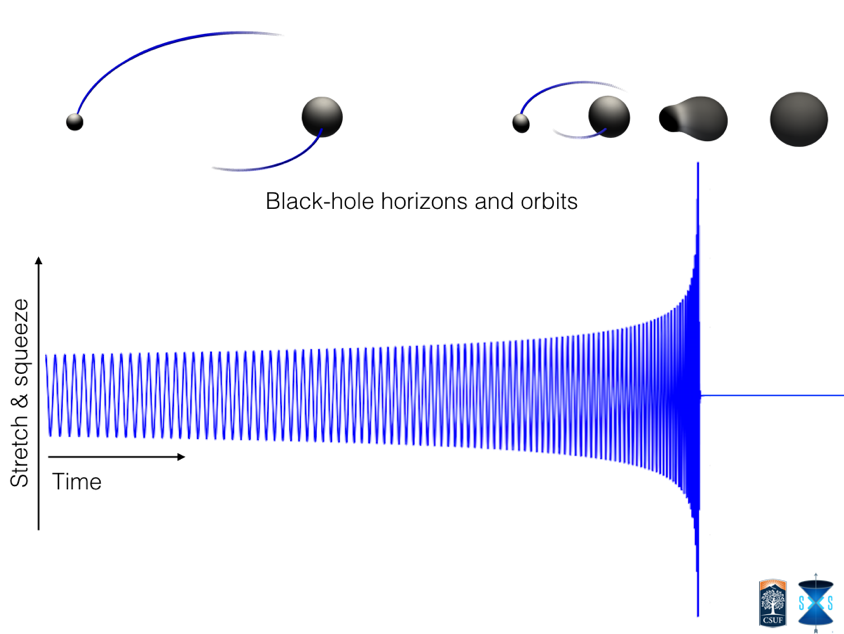
Student outcomes - The research at GWPAC provides discovery-level scientific opportunities to students at Cal State Fullerton and benefits greatly from their contributions. Since its inception, GWPAC has trained 39 students in research. Eight of those students are now in PhD programs across the United States: Thomas Abbott (LSU Physics), Matt Giesler (Caltech Physics), Reza Katebi (Ohio Physics), Kevin Kuper (Arizona Optics), Fabian Magaña-Sandoval (Syracuse Physics), Erik Muniz (Syracuse Physics), Daniel Vander-Hyde (Syracuse Physics), Gabriela Serna (Syracuse Science Teaching). Nine of our former students are applying their skills in industry: Evan Foley (DNB Engineering), Gabe Islas (Liminit), Cinthia Padilla (Northrop Grumman), Chris Francis (Air Force), Chris Griffo (Celestron), Brian Kuper (Cytec), Jackie Lee (Northrop Grumman), Po-Feng Chen, and Skye Harris. Other students are pursuing different degrees: Sarah Wood and Susan Vong (transferred to UC Berkely), and Phillipe Rodriguez (Stanford MBA program). Veronica Lockett, April Hankins, and Ivan Ozaeta are teaching as adjunct faculty. GWPAC members have authored more than 30 publications since the center formed, many with student co-authors, as listed on the GWPAC publications page. Additionally, center members have given dozens of presentations at national and international meetings, conferences, and colloquiums.

2016 has been no exception. Nousha Afshari gave one of two student speeches at the 2016 CNSM commencement. Haroon Khan traveled to Brazil to present on the gravitational-wave discovery. And GWPAC students gave a number of excellent presentations at both the 2016 April American Physical Society Meeting and the 2016 SACNAS National Conference.
GWPAC, together with partners at Syracuse University, also began a new NSF-funded Partnership in Astronomy and Astrophysics (PAARE). This five-year program, led by Prof Jocelyn Read, is currently supporting research by CSUF students and Syracuse graduate students and will support a summer undergraduate research program with three students from Citrus College each year.
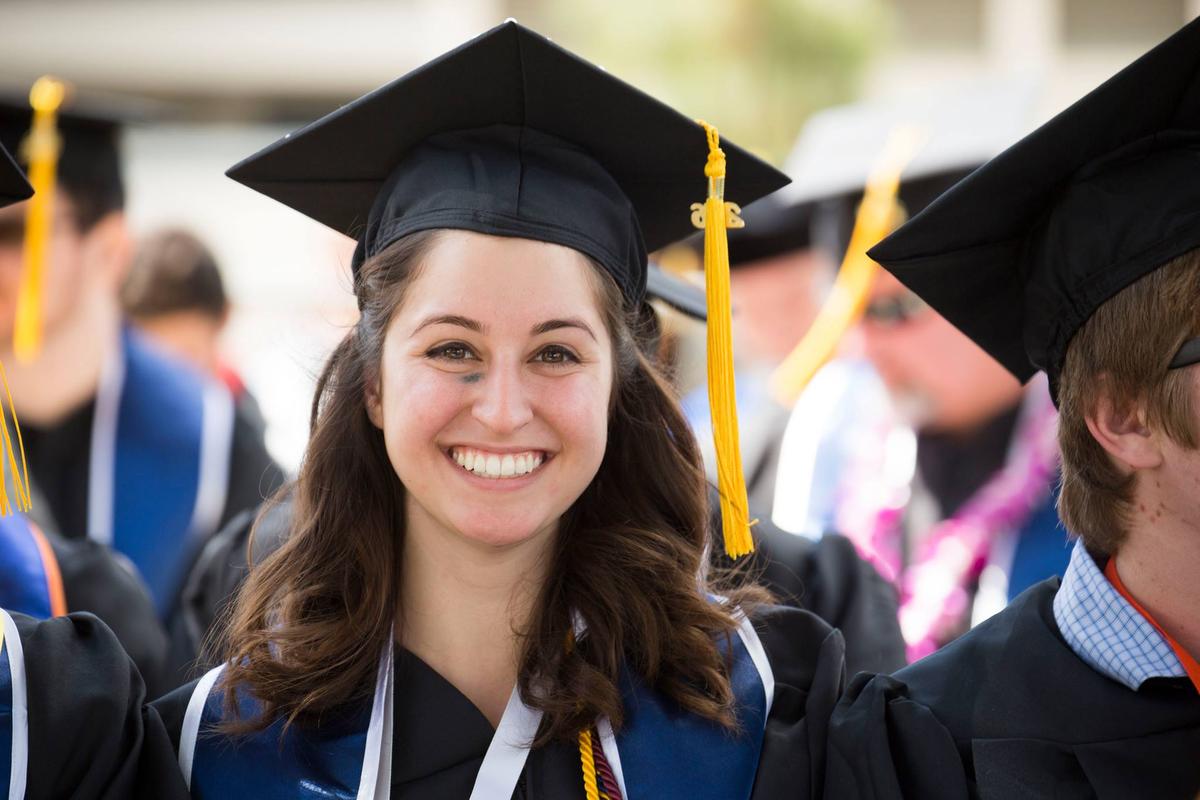
Outlook –
The groundbreaking discoveries of gravitational waves from binary black holes in 2015 have opened a new field of astronomy. Cal State Fullerton’s GWPAC is well positioned to continue and to expand its contributions to gravitational-wave astronomy and to help make new discoveries, interpret their implications, and communicate them to other scientists and to the public. The center’s undergraduate and master’s students will continue to play crucial roles in this early work at the dawn of the age of gravitational-wave astronomy.
In particular, Smith will attack the problem of light loss from imperfections in LIGO optics to help increase the volume of the universe that LIGO can see; Read will continue a leading role in the search for gravitational waves from systems that involve neutron stars, likely LIGO’s next big discovery; and Lovelace will expand work in theoretical understanding of thermal noise, one of LIGO’s most important limitations, and in how space and time behave in the extreme gravity of black holes and neutron star binary systems.
A key direction forward will be to identify areas of overlap between the existing GWPAC research and Al Agnew’s mathematical relativity group. We expect all GWPAC members to benefit from the addition of mathematical relativity to our research directions.
Finally, we are conducting a search for a Postdoctoral Research Associate and we hope to hire a talented person in early 2017.
Happy New Year from all of us at GWPAC!
GWPAC Members Past and Present Shine at SACNAS 2016
2016 was a year to remember for GWPAC at the SANCAS meeting with group members from past and present in
attendance.
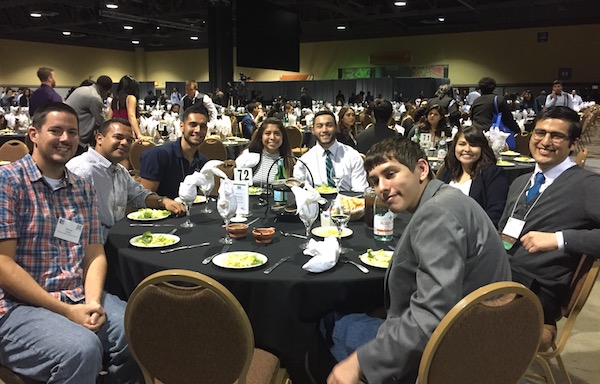
Participating in the meeting from Cal State Fullerton and GWPAC were undergraduates Michelle Aleman, Jeff Bidler, Isa Patane, and Juan Rocha, MS student Adrian Avila-Alvarez, and professors Geoffrey Lovelace and Josh Smith; From our partner, Syracuse University, former CSUF GWPAC members and now Syracuse PhD students Fabian Magaña-Sandoval, Gaby Serna and Daniel Vander-Hyde attended; LSC Spokesperson Gabriela Gonzalez, who helped open GWPAC in 2012 was a keynote speaker; Our friends from LIGO Hanford, Gerardo Moreno and Corey Gray, attended with the LIGO booth as did CSUF physics colleague Professor Gina Passante, physics education researcher and member of the Catalyst Center.
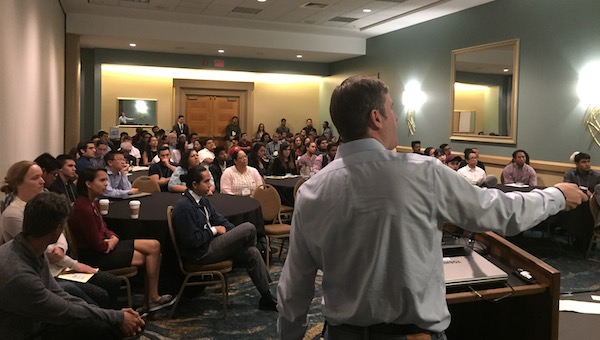
Many of our attendees also presented their research in talks and posters. Prof Smith chaired a scientific session called "Gravitational Waves: Opening a New Window on the Universe" and Prof Lovelace gave a presentation in the session about black hole mergers. Prof Passante presented her work in a Scientific Symposium talk entitled, "Using research to improve the teaching and learning of quantum mechanics." Adrian Avila-Alvarez presented a poster on "Assessing whether point-like optical scattering in LIGO optics are related to the annealing process" and Juan Rocha presented a poster on "Assessing the scattered light of crystalline-coated optics for future gravitational-wave detectors." Fabian Magaña-Sandoval presented a talk on part of his thesis work at Syracuse, "Adaptive mode matching upgrade for use of squeezed light in LIGO." During the dinner on Saturday all LIGO scientists in attendance, including many GWPAC members, were invited to the stage to be recognized for the first direct detection of gravitational waves in 2015. Gabriela Gonzalez then gave a scientifically and personally inspiring keynote about the gravitational-wave discoveries and her journey from being a young student in Argentina to becoming the spokesperson of the LIGO Scientific Collaboration.
We look forward to SACNAS 2017!
GWPAC Postdoctoral Associate Position
The Gravitational-Wave Physics and Astronomy Center (GWPAC) at California State University welcomes applications for a Postdoctoral Associate in Gravitational-Wave Physics. GWPAC faculty members include Al Agnew, Geoffrey Lovelace, Jocelyn Read, and Director Joshua Smith. Its research projects include searches for binary systems with black holes and neutron stars with the Laser Interferometer Gravitational-wave Observatory (LIGO), characterization of the LIGO detectors, waveform modeling including analytical solutions for neutron stars with realistic equations of state, modes and tides, numerical relativity simulations of binary black hole and black hole neutron star systems as part of the Simulating eXtreme Spacetimes (SXS) Collaboration, optical characterization of LIGO optics, theoretical calculations of thermal noise and mathematical relativity. The successful applicant will establish and carry out a research program in gravitational-wave physics that compliments the existing strengths in GWPAC and involves undergraduate and master’s students. Women and members of groups traditionally underrepresented in physics and astronomy are especially encouraged to apply.
The application deadline is 10/31/16 or until filled.
More information is available at http://asc1app.fullerton.edu/ascjobs/Job%201296R.pdf
Please note that our human resources department uses a fairly generic (and aging) form for the application. When navigating it, on page 4, note that you’ll probably need to choose “Other” for your major, because physics and astronomy are not listed. On page 6, it’s not necessary to enter anything. It’s not necessary to enter a driver license on page 7. For employment history, only list positions held after the date you received your doctorate. If you have any trouble uploading your files, please send them directly to me at josmith@fullerton.edu
Big year for gravity and GWPAC at the 2016 April APS Meeting
GWPAC students Nousha Afshari, Torrey Cullen, Nick Demos, John Derby, Alyssa Garcia, Haroon Khan, and Conner Park, and faculty Geoffrey Lovelace, Jocelyn Read, and Josh Smith attended the April 2016 Meeting of the American Physical Society, held in Salt Lake City, Utah.
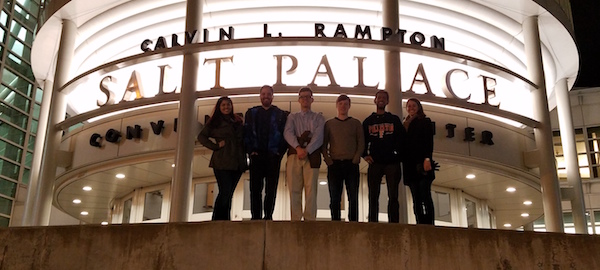
The meeting brought together hundreds of physicists from 18 divisions of APS. It also marked two milestones for the field of gravitation, the discovery of gravitational-waves from a merging binary system of black holes and the APS Topical Group on Gravitation becoming the APS Division of Gravitational Physics.
Among the many excellent presentations at the meeting were 8 by GWPAC members: 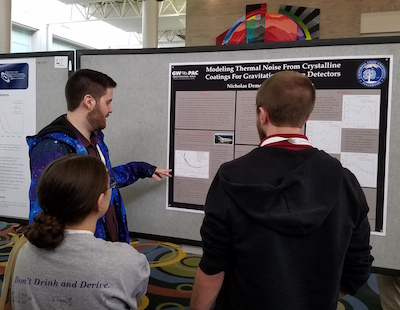
Nousha Afshari’s poster, “Comparing numerical and analytic approximate gravitational waveforms,”
Torrey Cullen’s poster, “Hybridizing Gravitational Waveforms of Inspiralling Binary Neutron Star Systems,”
Nick Demos’ poster, “Modeling Thermal Noise from Crystaline Coatings for Gravitational-Wave Detectors,”
Alyssa Garcia’s poster, “Making and Testing Hybrid Gravitational Waves from Colliding Black Holes and Neutron Stars,”
Haroon Khan’s poster, ``Visualizing the gravitational lensing and vortex and tendex lines of colliding black holes,”
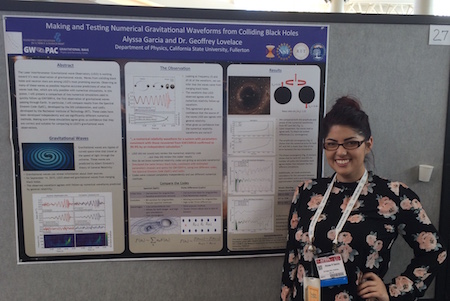
Geoffrey Lovelace’s talk, “Modeling rapidly spinning, merging black holes with numerical relativity for the era of first gravitational-wave observations,”
Conner Park’s poster, “Modeling Binary Neutron Stars,” and
Jocelyn Read’s talk, “Gravitational waves from neutron-star mergers.”
Additionally, Cal State Fullerton professor Gina Passante, who has taught most of the GWPAC students quantum mechanics, presented a talk on her physics education research entitled, "Student understanding of the time dependence of spin-1/2 systems."
Outside of the meeting, the Fullerton attendees found time to visit the local eateries, visit the Salt Lake, and hike Red Butte Canyon and Millcreek Canyon with their fellow physicists.
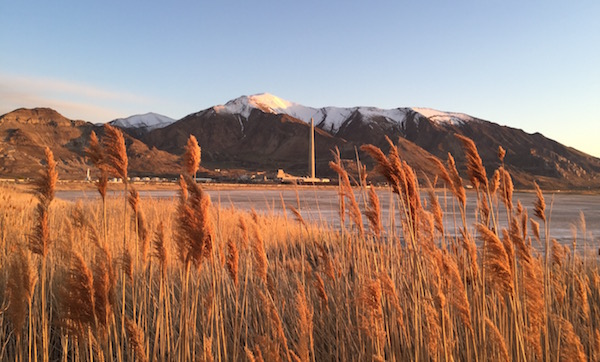
GWPAC Visiting Member Prashanth Jaimumar Receives NSF Funding to Investigate Quark Matter
Cal State Long Beach Associate Professor and GWPAC Visiting Member Prashanth Jaikumar has been awarded funding by the National Science Foundation's Nuclear Theory and Astrophysics program for the project "RUI: Probing Quark Matter through Compact Star Oscillations." The project aims to improve the odds of detecting the gravitational waves from neutron stars by constructing accurate mathematical models of neutron stars and the signals they emit. Prashanth and his students will calculate the oscillation modes of compact stars made in part or entirely of strange quark matter and work to identify trends in the mode spectrum that can be used as gravitational wave fingerprints of the inner structure of neutron stars.
This research has strong overlap with existing GWPAC projects including binary neutron star and neutron star black hole waveform modeling and numerical relativity. "I hope to strengthen my ties with GWPAC through this grant and the student research it will support." says Prashanth.
Congratulations Prashanth, we look forward to working with you on neutron/quark star research!
The Orange county Relativity Cluster for Astronomy (ORCA)
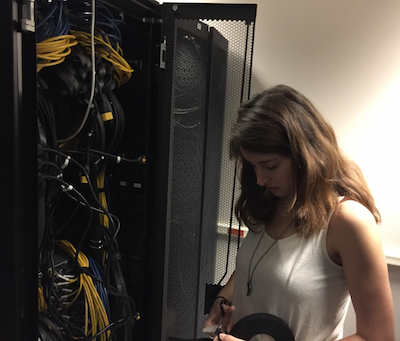
With funding from the Research Corporation for Science Advancement, a Major Research Instrumentation award from the National Science Foundation, and startup funds from California State University Fullerton, GWPAC has completed a major upgrade and expansion of its local computing cluster, the Orange county Relativity Cluster for Astronomy (ORCA).
The machine, housed in the University Data Center, now has more than 1500 gigabytes of memory, more than 30 terabytes of local storage, and 576 compute cores that together are capable of more than 7 trillion operations per second. This more than doubles the number of student projects that ORCA can support, including simulations of merging
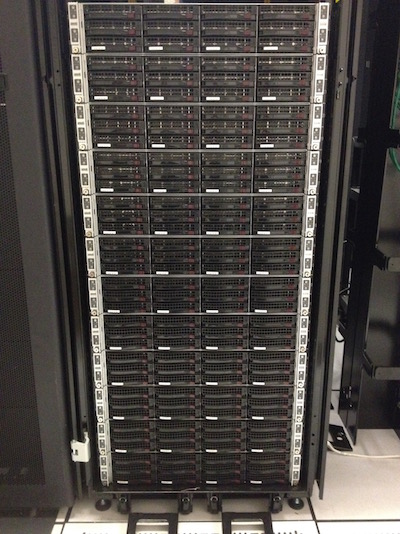
black holes and neutron stars, gravitational-waveform modeling, and LIGO detector characterization algorithms.
A team of GWPAC students assisted in assembling, cabling, and testing the new hardware on Friday October 17 and Monday October 20. After benchmarking and temperature testing, ORCA is now again producing gravitational-wave science results.
